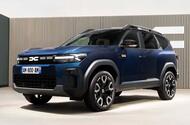This post was originally published on Autocar
Family-sized 4×4 will land in the UK next year in full-hybrid and mild-hybrid guises
The Bigster is Dacia’s largest model yet and kick-starts the Romanian brand’s ambitious plans to expand into the ultra-competitive C-segment market.
Claimed by Dacia to make the “C-SUV more affordable”, the long-awaited Bigster will sit above the technically-related Duster crossover and is set to arrive next year at a sub-£30,000 price that will undercut key rivals such as the Skoda Kodiaq, Peugeot 5008 and Ford Kuga.
Positioned as a cut-price alternative to the Land Rover Defender, the Bigster comes with four-wheel drive, “genuine off-road capabilities” and a rugged exterior design that remains largely faithful to the concept first shown in 2021.
Protruding wheel arches, sharp-looking LED headlights and large, 19in alloy wheels endow the Bigster with a brawny appearance that’s similar in vein to the recently overhauled Duster.
The Bigster sits on the Renault-Nissan-Mitsubishi CMF-B platform, which is shared with the Duster, Sandero, Jogger and Clio. As a result, it is being launched with a mix of electrified powertrains.
The flagship model is the Hybrid 155, which pairs a 107bhp four-cylinder petrol engine with two electric motors (a 50bhp motor and a high-voltage starter-generator) and a 1.4kWh battery. The Bigster is the first Renault Group car to be fitted with this set-up.

Outputting 153bhp via a six-speed automatic gearbox, it is the most powerful Dacia model to date. The firm also claims it can be driven in pure-EV mode 80% of the time.
Customers can also opt for the TCe 140, which combines a 138bhp 1.2-litre three-cylinder turbocharged petrol engine with a 48V mild-hybrid system. At the foot of the range is the TCe 130, which is also used by the smaller Duster but features four-wheel drive. Both are available with a six-speed manual gearbox only.
Inside, the Bigster majors on “space, ergonomics and comfort”, according to Dacia. New features – such as thicker glass, improved acoustic padding, adjustable seats and dual-zone climate control – have been added to “meet the expectations of customers” looking for a C-segment SUV.
The high-mounted dash is dominated by a 10.1in central touchscreen, which gets smartphone mirroring as standard.
A huge 667 litres of seats-up boot space puts it on a par with the similarly sized Kodiaq and 5008.
Commenting on the launch of the Bigster, Dacia design boss David Duran said: “For the C-segment, you need a car that stands out, so its good to be a bit different by coming with a tough-looking car that is spacious, but also that has functionality to appeal to buyers. And it goes well with our affordable positioning, too. “
“A rugged design makes sense for us becuase we want our cars to be used as a tool. I have an old Land Rover Series II and for me this is the perfect example of a rugged, reliable tool that you can use everywhere. This is the type of design that I love and I try to apply to our cars becuase we want people to feel proud in our cars, and you don’t always need to have a super expensive car to look good,” he added.
The Bigster will arrive in the UK priced from around £29,000 and top out at close to £35,000, making it Dacia’s most expensive model to date.

